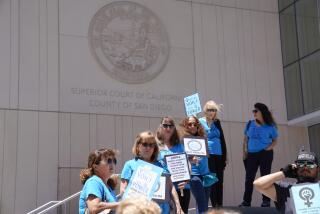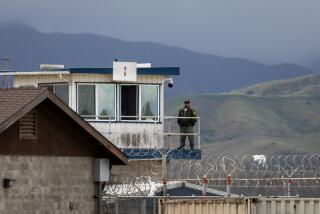Fewer State Ex-Inmates Returning to Prison
SACRAMENTO — Fewer than 40% of the inmates released from state prisons in 2003 were back behind bars one year after their release, the lowest rate in a quarter of a century, corrections officials announced Monday.
California’s two-year return rate, which some experts consider a more useful barometer, also has declined, reaching its lowest point since 1991.
That number has been dropping steadily over the last four years. Of the 54,877 inmates who were paroled in 2003, a little more than half -- 51.09% -- were back in custody after two years of freedom.
The rate at which parolees run afoul of the law again -- recidivism -- is widely viewed as the most telling measurement of how well programs for inmates and ex-convicts are working.
The reasons for the downward trend are not yet clear. But officials speculated that expanded parolee and prisoner programs, changes in the law and better community services for ex-convicts all played a role.
Acting Corrections Secretary Jeanne Woodford called the new data, calculated by her researchers, “promising.”
“While it is still early, this kind of information shows we are heading in the right direction,” Woodford said. She added that “every drop in the recidivism rate means fewer victims in our neighborhoods.”
In testimony before the state Legislature recently, Woodford said her goal was to reduce the recidivism rate an additional 10% by 2010. She repeated that pledge Monday.
Although other states report better rates than California, comparing recidivism among jurisdictions is difficult because of differences in the definition and in how such rates are calculated.
Nationally, the Bureau of Justice Statistics -- the research arm of the U.S. Justice Department -- reports that 41% of convicts released from state prisons in 2000 successfully completed their parole. That number, the bureau said, has remained relatively unchanged since 1990.
While encouraged by the numbers in California, experts who monitor trends in incarceration and parole said unraveling what has caused the drop would be complicated.
“There’s no question that this is a hopeful sign,” said Barry Krisberg, president of the National Council on Crime and Delinquency, an Oakland research and advocacy group. “But to really understand what it means, you have to plow deeply into the data.”
Among the unanswered questions, Krisberg said, was what proportion of the inmates were sent back to prison for new crimes and what proportion were rearrested for violating terms of their parole.
Krisberg also said he was a bit surprised by the data, partly because of the severe crowding plaguing California prisons, which corrections officials say are at 200% of their intended capacity. Among other things, crowding has consumed classrooms and other prison space intended for expanded education and vocational programs, undermining efforts to better prepare parolees to stay crime-free.
“The Schwarzenegger administration is doing a lot to expand in-prison treatment and reentry programs for parolees,” Krisberg said. “I just wouldn’t expect to see a payoff yet.”
California researchers calculate the recidivism rate by tracking felons paroled in a calendar year and calculating the ratio of those who have been returned to custody over a one-year and two-year period.
Included in the total are those who commit a new felony and those who violate their parole and are sent back to prison for a brief term, usually about three months.
Slightly more than 38% of all inmates released in 2003 landed back inside by the end of the next year, the lowest rate since 1979. That one-year recidivism rate has been dropping overall since 1997, when it was just under 45%. It peaked in 1988 at about 54%.
Of the 54,977 parolees released from prison in 2003, the largest number -- 4,416 -- were returned to custody for narcotics possession. An additional 2,336 were sent back to prison for assault and battery, while 2,103 were rearrested for second-degree burglary and 2,080 for auto theft.
At any time, California has roughly 115,000 parolees under supervision, most of them for two years.
More to Read
Sign up for Essential California
The most important California stories and recommendations in your inbox every morning.
You may occasionally receive promotional content from the Los Angeles Times.










